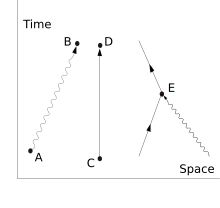Quantum electrodynamics
Appearance

In particle physics, quantum electrodynamics (QED) is the relativistic quantum field theory of electrodynamics. In essence, it describes how light and matter interact and is the first theory where full agreement between quantum mechanics and special relativity is achieved.
| This science article is a stub. You can help out with Wikiquote by expanding it! |
Quotes
[edit]- When after some weeks I had a chance to talk to Oppenheimer, I was astonished to discover that his reasons for being uninterested in my work were quite the opposite of what I had imagined. I had expected that he would disparage my program as merely unoriginal, a minor adumbration of Schwinger and Feynman. On the contrary, On the contrary, he considered it to be fundamentally on the wrong track. He thought adumbrating Schwinger and Feynman to be a wasted effort, because he did not believe that the ideas of Schwinger and Feynman had much to do with reality. I had known that he had never appreciated Feynman, but it came as a shock to hear him now violently opposing Schwinger, his own student, whose work he had acclaimed so enthusiastically six months earlier. He had somehow become convinced during his stay in Europe that physics was in need of radically new ideas, that this quantum electrodynamics of Schwinger and Feynman was just another misguided attempt to patch up old ideas with fancy mathematics.
- Freeman Dyson, Disturbing the Universe (1979), p. 73
- The theory of quantum electrodynamics describes nature as absurd from the point of view of common sense. And it fully agrees with experiment. So I hope you can accept nature as She is—absurd.
- We physicists are always checking to see if there is something the matter with the theory. That’s the game, because if there is something the matter, it’s interesting! But so far, we have found nothing wrong with the theory of quantum electrodynamics. It is, therefore, I would say, the jewel of physics—our proudest possession.
The theory of quantum electrodynamics is also the prototype for new theories that attempt to explain nuclear phenomena, the things that go on inside the nuclei of atoms. If one were to think of the physical world as a stage, then the actors would be not only electrons, which are outside the nucleus in atoms, but also quarks and gluons and so forth—dozens of kinds of particles—inside the nucleus. And though these “actors” appear quite different from one another, they all act in a certain style—a strange and peculiar style—the “quantum” style. At the end, I’ll tell you a little bit about the nuclear particles. In the meantime, I’m only going to tell you about photons—particles of light—and electrons, to keep it simple. Because it’s the way they act that is important, and the way they act is very interesting.- Richard Feynman, QED: The Strange Theory of Light and Matter (1985), Ch. 1. Introduction
- With the help of W Furry, Weisskopf ... showed that the inclusion of positrons in the electron self-energy calculation reduced the degree of divergence to ln(1/r0), where r0 again represents a minimum cut-off distance. Thus positrons were a partial, but not sufficient, help.
Another infinite quantity occurring in quantum electrodynamics arises as a result of the production of virtual electron-positron pairs by a photon. Like the electron self-energy, this vacuum polarization divergence depends on the logarithm of a cut-off parameter. Despite the infinite nature of vacuum polarization, it was possible to calculate its effect on the Coulomb interaction, for instance in a hydrogen atom, by comparing the interaction at large and shorter distances.- Val L. Fitch and Jonathan L. Rosner, in: Brown, Laurie M.; Pais, Abraham; Pippard, Brian, eds. (1995). "Chapter 9. Elementary particle physics in the second half of the twentieth century". Twentieth Century Physics, Vol. II. Institute of Physics Publishing. pp. 635–794. (quote from p. 641)
- The history of QED in the period from 1946 to 1949 has many similarities with the history of the developments of quantum mechanics from 1925 to 1927, when Schrödinger and Heisenberg had propounded two different approaches to quantum mechanics. The correspondence can be taken to be: Feynman is to Heisenberg what Tomonaga-Schwinger is to Schrödinger, with Dyson initially playing the role of Pauli, Schrödinger, and Eckart in proving the equivalence of the two approaches.
- Silvan S. Schweber (1994). QED and the Men who Made it: Dyson, Feynman, Schwinger, and Tomonaga. Princeton University Press. p. 12. ISBN 0-691-03327-7.
- Once we got past the obscurities produced by spontaneous symmetry breaking in the weak interactions and color trapping in the strong interactions, the Standard Model was revealed to us as a theory that was really not very different from quantum electrodynamics. We had more gauge fields, not just the electromagnetic field but gluon and W and Z fields. There were more fermions, not just the electron but a whole host of charged leptons and neutrinos and quarks. But the Standard Model seemed to be quantum electrodynamics writ large.
- Steven Weinberg: (2021). "On the Development of Effective Field Theory". arXiv preprint arXiv:2101.04241. (quote from p. 2)

